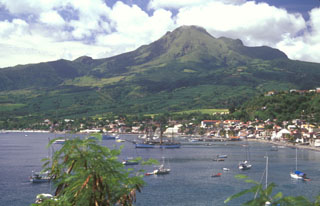Report on Pelee (France) — 13 January-19 January 2021
Smithsonian Institution / US Geological Survey
Weekly Volcanic Activity Report, 13 January-19 January 2021
Managing Editor: Sally Sennert.
Please cite this report as:
Global Volcanism Program, 2021. Report on Pelee (France) (Sennert, S, ed.). Weekly Volcanic Activity Report, 13 January-19 January 2021. Smithsonian Institution and US Geological Survey.
Pelee
France
14.809°N, 61.166°W; summit elev. 1372 m
All times are local (unless otherwise noted)
L'Observatoire Volcanologique et Sismologique de Martinique (OVSM) reported that seismicity at Pelée remained at significant levels during 8-15 January, though had slightly decreased compared to the previous week. The seismic network recorded at least 22 high-frequency, volcano-tectonic earthquakes with magnitudes less than 1, located at shallow depths between 600 and 1,000 m above sea level. Two low-frequency, long-period earthquakes were also noted. The Alert Level remained at Yellow (the second lowest level on a four-color scale).
Geological Summary. Montagne Pelée forms the northern end of the island of Martinique. Three major edifice failures since the late Pleistocene, the last about 9,000 years ago, have left large scarps open to the SW inside which the modern volcano has been constructed. More than 20 large eruptions have occurred here during the past 5,000 years. Extensive pyroclastic-flow deposits, incised by steep-walled ravines, mantle the slopes of the volcano. The l'Etang Sec summit crater is filled by two lava domes emplaced during the 1902 and 1929 eruptions. Moderate phreatic or phreatomagmatic eruptions in the Upper Rivière Claire valley were recorded in 1792 and 1851-52. The catastrophic 1902 eruption, which destroyed the city of St. Pierre, became the type-example of Pelean eruptions and marked the onset of modern volcanological studies of pyroclastic density currents.
Source: L'Observatoire Volcanologique et Sismologique de Martinique (OVSM)

